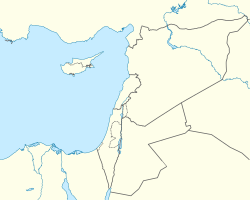עין אֵסוּר | |
 Aerial photo of Tel Esur in the foreground with En Esur to the left, Highway 65 in the middleground, and Barkai in the background | |
| Alternative name | 'Ein Asawir |
|---|---|
| Location | Menashe, Haifa, Israel |
| Region | Canaan, Southern Levant |
| Coordinates | 32°28′55″N 35°1′10″E / 32.48194°N 35.01944°E |
| Type | Proto-city |
| Area | 50 ha (120 acres) |
| History | |
| Founded | Chalcolithic (c. 5000 BCE); Early Bronze Age I (c. 3000 BCE) |
| Abandoned | Early Bronze Age IB,[1] mid-8th century BCE (Iron Age IIB),[2] 3rd century BCE (Hellenistic period)[3] |
| Periods | Pottery Neolithic (PN) – Early Bronze Age I (EBI)[1] |
| Cultures | Yarmukian (PN), post-Wadi Rabah culture (Early Chalcolithic), Ghassulian (Late Chalcolithic), Canaanite (Early Bronze Age IA) |
| Site notes | |
| Archaeologists |
|
'En Esur, also En Esur (Hebrew: עין אֵסוּר; [ʕen ʔesuʁ] eh-N eh-s-oor) or Ein Asawir (Arabic: عين الأساور, lit. 'Spring of the Bracelets'), is an ancient site located on the northern Sharon Plain, at the entrance of the Wadi Ara pass leading from the Coastal Plain further inland. The site includes an archaeological mound (tell), called Tel Esur or Tell el-Asawir, another unnamed mound, and two springs, one of which gives the site its name.
A 7,000-year-old Early Chalcolithic large village already showing signs of incipient urbanisation and with an open space used for cultic activities was discovered at the site below later, Bronze Age remains.[4]
During the Early Bronze Age, around 3000 BCE, a massive fortified proto-city with an estimated population of 5,000 to 6,000 inhabitants existed there. It was the largest city in the region, larger than other significant sites such as Megiddo and Jericho, but smaller than more distant ones in Egypt and Mesopotamia. The city was discovered in 1977, but its massive extent was realized only in 1993. A major excavation between 2017 and 2019 ahead of the construction of a highway interchange exposed the city's houses, streets and public structures, as well as countless artifacts including pottery, figurines and tools. Archaeologists announced its discovery in 2019, calling it the "New York of the Early Bronze Age".[5]
- ^ a b 'En Esur (Asawir): Preliminary Report (16/07/2018). Hadashot Arkheologiyot 130.
- ^ Cite error: The named reference
ShalevBarwas invoked but never defined (see the help page). - ^ Cite error: The named reference
AFPawas invoked but never defined (see the help page). - ^ Elad, Itai et al., "'En Esur (Asawir), Area N: Preliminary Report (26/10/2020)", in HA-ESI 132 (2020)
- ^ "Bronze Age 'New York' discovered, Israeli archaeologists say". Deutsche Welle. KNA/AP. 7 October 2019. Archived from the original on 6 October 2019. Retrieved 7 October 2019.

